Thai Music
Thailand is a fascinating country of that there is no doubt and its popular music one of the most fascinating aspects of its culture. Trying to find the real music of Thailand is not always easy, certainly not for the casual holidaymaker there for a couple of weeks. The guidebooks and tourist shows are full of Classical Thai music and maybe a bit of rural dancing and singing but interesting as these might be they are hardly the day by day cultural pursuits of the man in the street. If you venture into a bookshop in Thailand you will have a large choice of titles by foreign drug traffickers banged up for dozens of years, or by former bargirls putting their side of the whoring story alongside plenty of glossy heavyweight picture books featuring Thai wooden houses, Temples and so on, but you will search for anything on Thai music in vain. Ask an assistant and they will look bemused and at most might point you to something connected with his Majesties compositions. If you can read Thai things are little better in a Thai shop, although there are recently some very interesting publications which I will list as they are worth getting for those interested. Get into a taxi and things improve-the chances are quite high the driver will be from upcountry and will be listening to 95 FM, 88.5 FM or the new 94.5 FM all luktung / morlam stations, he will also often turn it right down or off for Mr. farang so don’t be afraid to ask him to turn it up. Of course there is always the internet , but information in English is not always very reliable (even maybe some details here!) then there is the large number of VCD and TV clips on YouTube, but who knows how long they will remain available with copy write issues surrounding that site.
There are said to be over 70 native languages and dialects spoken in Thailand, I am not sure how many styles of music there are but it does reflect the ethnic diversity of the Country. As well as luktung, there is likay, pleng lair, lam tad, pleng choi, lukrung, pleng ho (central) kantrum, (from khamin areas) string, pleng phua chewit (modern pop and folk) bong lang, morlam in all its many forms (N Eastern) nang taloong, nooraa (Southern) pii klong (muay Thai). These are just some of the styles, classical, hill tribe, and Chinese music need including as well to what is nowhere near a complete list. The most popular and widespread styles are string, pleng phua chewit, luktung and morlam.
If anyone was unfortunate enough to see much of the PAD protest broadcasts on Thai TV up to the beginning of December 2008 they would have noticed many concert performances over the weeks of broadcast. There could not have been a greater advertisement as to what strata of society the yellow PAD protesters mainly came from, you only had to clock the musical styles to see that. Many will know that the PAD support came mainly from the older urban rich elite who had their noses pushed aside by the Thaksin years and that they were more concerned with loss of power than any, a bit late to some, concerns about corruption in high places. So there was not one (as far as I saw) luktung singer and god forbid any morlam performers invited to their rallies, maybe because no such performers supported the PAD aims. So it was many old lukrung crooners and pleng phua chewit artists graced the PAD stage day after day banging out their songs in support of the establishment, particularly odd when the pleng phua chewit style (songs for life) originally grew out of the Student protest movement of the 70’s, now here they were voicing their support for the old order.
I saw one TV report on the Reds gathering in Bangkok over New Year 2008 and sure enough they were dancing around a guy playing the kaen (Lao reed instrument) and dancing to morlam.
Luktung
Thailand is still a very class ridden society as the recent political troubles have shown up only too well. The rural poor are still, for the most part, Just that and despite decades of economic growth not a lot seems to have filtered down to people from Issan or the North who have migrated in millions to work in the capital, mostly for low wages. One way out of poverty has been to become a successful luktung singer and those now famous were formerly waitresses, factory workers, noodle sellers or even toilet jockeys. True there are a few with University degrees, but these are the exception rather than the rule. Luktung is the most popular nationwide style of Thai music to have its roots in old Thai folk traditions, and I find it’s ever changing developments make it the most interesting, so this is the style I will write a little about.
Fifty years ago or so years ago there was little difference between luktung and lukrung (romantic city music), back then what became to be called luktung (in 1964 TV show) was commonly called pleng talad (market music). The instrumentation was sometimes similar to lukrung, but the songs could have a more down to earth and less romantic themes than in lukrung. People tend to think of luktung these days as being music from Issan (N eastern area) but it developed from central Thai musical forms with later influences from abroad. Over the past decade or so morlam has certainly influenced luktung with Lao instruments sometimes used in luktung numbers and morlam singers often going over to sing luktung, or more often singing in both styles. This adapted sound with a heavy influence of the pin and the Kaen used in morlam, or using morlam rhythms is sometimes referred to as luktung prayuck or luktung / morlam. Few luktung singers seem to move the other way as it is more demanding to sing most morlam than luktung, and also less financially rewarding.
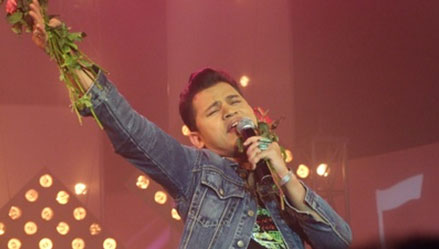
Bowee a southern singer had a million plus seller with Koon Mai Kap Rua in 2007
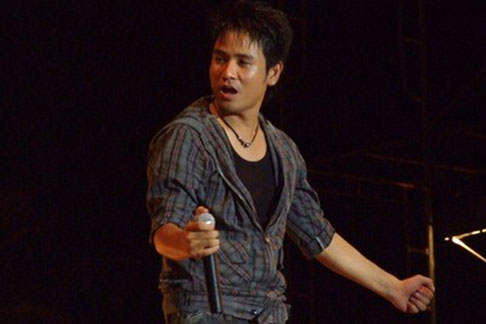
New Grammy singer Pi Phogsathorn, his Sao Kantrum number shows that luktung is not just influenced by the Lao sounds of morlam
The luktung sound is nothing like what it was 40 years ago and it continues to evolve, as well as the morlam influence there have been influences from other forms of Thai music. Recently this can be seen in a lot of R-Siam releases with some use of southern instruments and songs for life elements used in a few numbers such as in Bowee’s and Bew Kalayanee’s work. Kantrum has been used in luktung songs before and can be still heard in luktung numbers with recent work by Anna Arisa and in Pi Phogsathorn’s Sao kantrum song. Some luktung numbers from the south can have a very Indian sound and even Issan singers have recorded songs like this such as Go Some Pi recorded by Monsit in 1999, while Southern singers like Echachi Shivachi have recorded very Lao sounding numbers. Four decades ago a lot of luktung had a heavy brass sound and often used temple bells for percussion. Now it is as likely to be a full rock band as it is Lao, or southern instrumentation. Luktung has become a true national musical form with performers, regional flavours and fans from every corner of the kingdom. If you are thinking it sounds difficult to tell what is and is not real luktung you would be right with some releases by one or two companies, however, if it’s marketed as luktung I think it has to be accepted as such. The themes of luktung though have remained pretty much the same over the decades, songs about country folk moving to the big city, Lakorn Chewit by Mike Piromporn is a good example, unrequited love, songs about the hard life country people live. Schoolgirl crushes and lovelorn office girls falling for khun Jai dee, songs about drunkenness and unfaithful husbands abound and even songs about prostitution are not uncommon, also there are comic songs and just plain silly songs. This being Thai music there is also quite a number of songs about food, even Pumpuang sang about Som Tam!
Ancient History
Kamron Sambunarnon 1920-1969
Many of the early singers are almost unknown to younger Thai’s today even though in their time they were household names who also performed on radio, had large bands and often led colourful lives. Although he died just five years after the term luktung was coined Clark Gable look alike Kamron Sambunarnon is regarded as the father of luktung songs having written Jaw Sao Chow Rai (according to luktung historian Jenpop) in 1938 which seems very early. This pioneer also wrote and sang protest songs aimed at the establishment years before Carabao was even born. Whether it was this or his womanising that led to an acid attack on him is not known, but the playboy singer went on to appear in films before succumbing to lung cancer in 1969 at the age of 49. Kamrom also sang pleng ho (no not music by ladies of the night!) a style which according to song writer and DJ Surin Paksiri has almost disappeared. Pleng ho is characterised by yodelling and varies from what sounds like old fashioned luktung with a bit of yodelling thrown in to a full bodied American country sound complete with banjo’s and even Hawaiian guitar. One of Kamruns ho songs is Sawan Chaawnaa which was played on FM95 as recently as Dec 2008. Ho’s ultimate performer was Phet Panomrung, a big fan of Hank Williams Phet’s band dressed in Country and Western garb and songs such as Luktung Seang Tong sees Phet on the banjo including riffs such as Oh Susanna and other American melodies into a pure American Country sound. His Majesty must have approved as Phet received a royal ward in 1991 a long time after the height of his career. Recently the ho sound was used by Nopporn Silver Gold’s main star Mangpor in a song from 2007. I must admit I forget the title of this and cannot find it, but the VCD track shows her and the cast dressed in cowboy costume and it includes yodelling. Somewhat confusingly pleng ho is sometimes referred to as luktung cowboy and it shows how much Thai music was being influenced by foreign sounds from an early date.
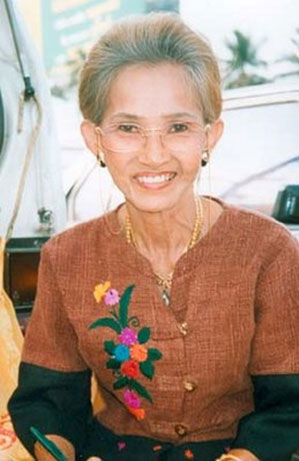
Khun Ponsri Warranut
An early Luktung singer from the 60’s who appeared in many bands including Surapon's who also wrote songs for her. Like many other singers from this time she came from the central area of Thailand as did Pumpuang, Sanyan Sanyar, Yodrak Salakjai, Sotsi Rungphatong and others. Seen here in 2002 she was still singing occasionally and her albums are still in the shops.
King and Queen of Luktung
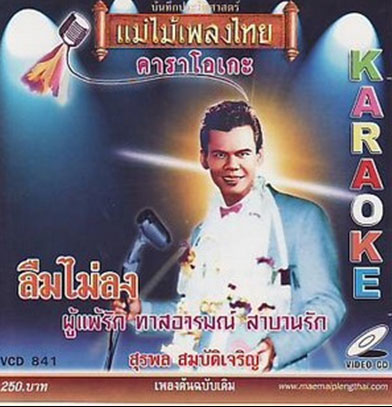
Surapon Sombatjaroern 1930-1968
The most influential and talented early singer, composer and band leader of the early years was Surapon Subatjaroern born in 1930. After failed attempts at studying engineering and teaching he was introduced to music in an armed forces band. Like many other early singers he came from the Suphanburi area which was to become almost the Tamla Motown of luktung as far as producing famous singers was concerned. The importance of Surapon in the history of luktung cannot be overstated nor can his enormous popularity in the 50’s and 60’s be ignored. As well as being a great songwriter the man they called the Thai Elvis also led the most successful band of that time and was responsible for the development of several other singers. He wrote for Ponsri Warranut and took Gangwaanprai Luukpet then Garn Geowsukpan (Khun Deang) under his wing as well as others who joined his band before starting their own bands. His life was tragically cut short when shot dead on August 16th 1968 by a killer using a USA army issued pistol, as far as I know the assassin was never caught. His son Surachi also became a successful singer in the 80’s but not before having to flee to the UK after his father’s death. He gave an interview in the early 80’s commenting on his father’s murder he says:
‘Almost everywhere we go in the Country there are local gangsters or protection racketeers who threaten us. They murder some of us, just as they murdered my father. At times there are bombs and gunfire. Then, the only thing to do is pray and asks God to look after us. Once travelling back with my driver and Uncle after show, a car pulled alongside and started to shoot at us. My driver was killed and my Uncle badly injured, I escaped. And then a few months later, there was another bomb attack while I was singing. Many people were hurt and over 100 died. Once they again they missed me. It was the same people who killed my father.’ (Some comments edited out)
Thankfully things are more peaceful at concerts these days, apart from the occasional seat throwing and drunken scuffles that is. Whatever criminal activity exists is either a lot less or more sophisticated than in the 60’s and 70’s.
Many of Surapon’s songs are still popular today and have been re recorded by other singers, of particular note is Got who covered his songs over several albums. As an indication of how popular Surapon and his music had become a movie inspired by his music, Monrak Luktung made in 1970 played for six months solid and took many millions of baht, an enormous sum for those days. Sadly the film has deteriorated to such an extent (unless recently restored) it is almost unwatchable now. It was however remade and there have also been at least two lakorn versions on TV, I think the last was on channel 7 in the 1990’s. I see from the www.imdb.com there was another film version in 2005 starring singers Appaporn Nakonsawan and Yingyong, however I have never seen it or noticed it on the shelves. The original film seems almost laughably crude and cheaply made these days but the music is the outstanding feature and worth looking at to see how luktung has changed from that time.
The success of Monrak Luktung was followed by many others. The luktung movie musical became a Thai genre in filmmaking, few were as good. Singers such as Pumpuang, Sayan Sanyar and Yodrak Salakjai appeared in films and most are still available on disc. The best modern quality similar film has to be Monrak Transistor from 2001, although no famous singers appear in it the storyline and acting is excellent and it includes music from, and is dedicated to the great man himself -Surapon. For a modern day film including luktung singers look no further than Mon Pleng Luktung FM from 2002 featuring the luktung expert DJ Jenpop. Although the storyline is by western standards a bit short of a full house, the film includes a short concert section at the end and is said to include 160 singers throughout the film, many appearing in fleeting cameo roles. Also available on DVD it’s a must see for any fan. There have been a couple of other films since but I don’t want to go on about films too long.
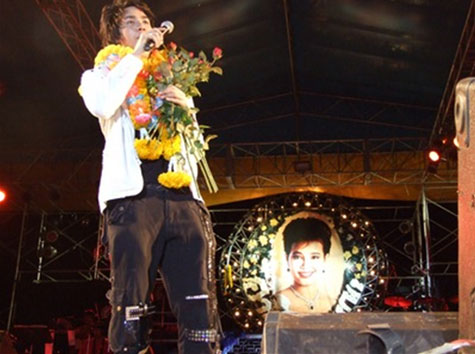
Pumpuang's son Nong Phet singing a duet with a recording of hers at Wat Trapkkadan
Pumpuang Duangchan 1961-1992
If Surpon was the king of luktung then Pumpuang is the undoubted Queen, hardly a day goes by when I do not hear one of her songs on the radio or TV in one form or another. An illiterate farm workers daughter one of 12 kids raised in Suphanburi district she started singing with bands from an early age. Even though she has been gone a long time her core works are timeless classics and she produced a new faster version of luktung with songwriter Khun Lopburi Rat often called electronic luktung. The great songwriter is often still seen judging contests and appeared in the Mon pleng luktung FM. film. But it was not all upbeat material, while songs like Nat Pop Naa Amphur and Ga Set kao Ma Sii drive along at dance speed others like Nakrawng Banok and Aye Sang Ne On were slower moving and full of feeling. John Clewley writes in the rough guide to world music that:
‘Pumpuang had the finest voice ever to grace the luktung stage. Powerful and full of emotion it raises goose bumps even on those who don’t understand Thai’
By coincidence as I am writing this channel 5 TV are showing footage of one of her last concerts in Bkk, she always had an incredible energy dancing like she’s in an aerobic session and singing at the same time. I never saw any TV footage of her which looks like lip sync, very common today in recorded shows. Three of her sisters are on the show singing her numbers and say she only had to hear a song twice to remember everything (she could not read) and that she was the first luktung singer to be appreciated by the so called Hi So audience with her concerts at the Dusit Thani in the 1980’s, I knew that but not hat she went to china in the mid 80’s which was where she became pregnant. Her son Nong Phet was also on the show and recalled if his mum had an evening concert she would make up in the afternoon and was never late, something one or two of today’s stars could do with emulating.
Some claims though in books that her death caused a void that some thought would lead to the demise of luktung are a little less than convincing. It is sometimes suggested that Sunaree Rachesima took over the legacy of Pumpuang. However, at the time of Pumpuangs death Sunaree was probably just as popular a singer with quite a different style of singing. The death of any artist can do wonders for their career as recently witnessed by the sad illness and death of Yodrak Salakjai; his CD’s have not sold as well since the 80’s! As with Surapon Pumpuang is rightly held in the highest affection by lovers of Thai luktung and although not many singers can emulate her range of emotions her songs are very often chosen by competition entrants. Few singers covering her songs can match her, only Yui Yatt Yerr (often wrongly claimed to be Pumpuang’s secret daughter) and Cathaleya Marasri have, in my opinion, come close to re capturing her magic on disc. Yui sang with Pumpuangs’s band for three years from about the age of nine. Nong Petch recently released his own version of his mum’s songs and appeared at the 2008 yearly concert on 13th June at Wat Trapkadan Suphanburi on the anniversary of her death singing an emotional duet with one of his mum’s recordings. For those interested the Wat near Suphanburi houses a small museum of Pumpuang and has her dresses and many photos’ along with some rather garish statues. It has become something of a cult place in recent years for those asking for favours or to divine winning lottery ticket numbers. Many singers cite Pumpuang as an inspiration including Appaporn and Cathaleya Marrasri. In Dec 2008 Dao Mayuree, Yui Yatt Yerr and Sunaree Rachasima appeared on TV stating how they were inspired by Pumpuang and that all of them sang her songs in competitions, Jintara also sang her songs in competitions. The influence and stature of Pumpuang in luktung cannot be overstated; she really is the standard by which female luktung singers are still judged today.
Yodrak Salakjai
Many will have seen media coverage of the illness and sad death of a luktung singer of thirty years Yodrak in 2008. Since the coverage many albums have been re released and a film about him Kwa Ja Pen Yodrak Salakjai has already been released. Unfortunately his illness became a media circus when his ‘friend’ the singer Sayan Sanyar said he believed Yodrak did not have the liver cancer he subsequently died off and that he would not be appearing at any benefits concerts. He later claimed, again on TV, that after Yodrak’s death the organiser of the concerts and fellow veteran singer Seri Rungsawan was channelling money raised for his own use, and using the publicity to boost his own career. All untrue, as far as I know all the money raised went straight to the family. It’s a pity Sayan did not show up at any concerts as they were very enjoyable and fitting tributes to Yodrak whose career stretched from the end of the golden age of luktung and who recorded over 4,000 songs. Interestingly there are still important singers around from the 60’s and 70’s, Waipoj Phetchsupan for example is still very active, but I expect he will have to pass on too before he gets a mention in the Nation!
Nopporn Silver Gold has recently released a very interesting VCD of a Yodrak concert filmed in 1986 at the height of his fame. Those were the days-no intrusive fans standing at the front taking endless photos on their mobile phones and the singer not immediately discarding the many mali’s presented for him to wear.
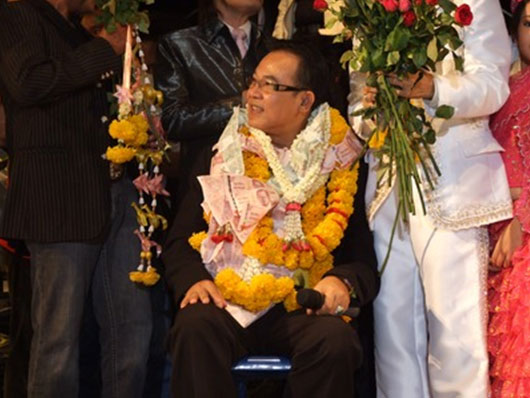
Yodrak at his last fund raising concert appearance in April 2008, he was too ill to sing
Modern singers
Jintara Poonlap
The number of good singers on the modern music scene is almost overwhelming and competition is fierce. Some of them clearly make a slender living at it even after years of trying. Some not so popular singers have to sell thousands of copies before they receive any royalties from the company releasing it, so it’s not all rags to riches by any means. If you don’t want to go to concerts or buy CD’s if you are in Thailand there are many shows on TV. Thursday and Friday has Noppporn Silver Gold’s Chung Tang Seang Tong talent show which also is a showcase for their own singers. Several famous singers have won this contest including the current female superstar Takkatan Choladar. On Saturday there is the long running 7-4 concert it covers all musical styles and often has top luktung and morlam singers. In the evening just after five you can get some idea just how talented the youngsters are on Chin Char Sawan, this is really worth watching, many schools and universities have Luktung troupes with their own bands and they are sometimes better than professionals. Channel 5 currently plays luktung VCD tracks from the latest albums weekdays 13-15 hours PM.
Some commentators have recently aired the view on TV that modern trends by recording companies is resulting in not just pretty faces please, but in songs that are too formulaic and too undemanding to sing well. It’s true that an awful lot of modern singers are easily copied whereas truly great singers such as Pumpuang, Surapon, Sunaree, Cathaleya Marrasri, Got, Mike Piromporn, Jintara Poonlap,Yodrak Salakjai and Monsit Khomsoi to name a few maintain a unique sound which is difficult to achieve by others and not often seen in newer singers. It’s no accident that in competitions most of these singers’ numbers are used by contestants to try and make the most of their vocal talents.
I’ll just mention a few singers whose work I have enjoyed over the years as well as one or two newer ones. Obviously there are scores of singers who are worth mentioning, but there is just not enough time to do justice to what would be an enormous list. www.ethaicd.com is a good place to look online, although they do have a different spelling for luktung if you do look on for the singers.

Jintara after a concert at the Dusit Zoo. I have seen this singer over 50 times and she rarely gives a disappointing performance, she is always fun to see and when the opening bars of Rak Sali Dok Fai Bann, one of the greatest country songs ever written, strike up it’s always dancing time. Some think of her a morlam singer but she started by singing luktung at competitions and her first few albums were all luktung. One number from her second album Warn Puen Kean Jot Mai is particularly worth hearing, full of emotion and not so easy to sing. Moved to R-Siam label in 2007 after Mastertape closed her second most recent album for them Yoo Karng Ter Samur is almost all morlam. Sadly the days of her big tour band came to an end with Mastertape going under, although she still appears at concerts. She regularly tours abroad including the USA, Europe and Australia; in 2007 she held concerts in Israel. Her list of great luktung songs is a long one including Taeng Mo Jintara, Naam Tar Sao Warin, Pa Yah Nak Faag Rak and Sao Udon Raw Rak. Although a few later albums on Mastertape were below par her best work easily makes up for that. Some people think Jin puts on a bit of an act but that’s not so, she is a very sweet and natural person with a great voice, and without any of the offhand attitude of one or two other famous names, a true superstar of luktung / morlam.
Takkatan Cholada
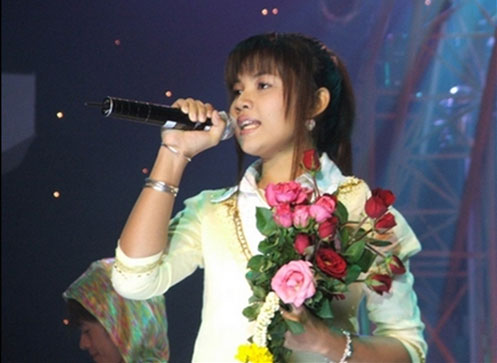
Takkatan at 7-4 concert -the latest star act from Grammy had a million plus seller with second album released in summer 2007. Songs from this album show how talented the Grammy writers are and it may be that they are even more important than the singers because while there are loads of competent luktung singers around writers such as Salaa Khunnawut are a rare breed. Having just heard her third album however it seems not quite up to the last one which would have been almost impossible so good was it and I heavily recommend her mega selling second album Thanon Kon Fhun. I have seen it reported that nobody would sign her as her looks did not meet the image that was being looked for. This obstacle was overcome with the surgeon’s knife and hey presto a star was born. If true it’s a sad reflection on the music companies today when looks are seen as that vital.
Cathaleya Marasri
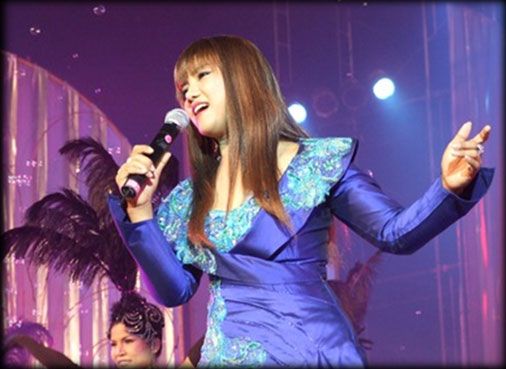
Cathaleya at a FM 95 concert, one of the most talented female singers who reminds me a lot of Pumpuang. Recently released a double album of Pumpuang’s songs, and unlike other such doubles by famous singers in recent years e.g. Mai, does not murder them. Cat is a bit of a flawed jewel in my opinion and while like Pumpunag many of her songs are already standards and she has been showered with awards, some aspects of her work is less than good. I am thinking of some of the VCDs she releases which are quite appalling, fans really deserves better than to see her filmed in front of a backdrop of computer effects, or scenes from around Thailand, cheap and disappointing. At the very least they should have dancers or better the mini lakorn drama which illustrates the song and which Grammy are the masters at. Songs such as Roy Plae Pen and Kon Rerm Mee Kwan Rak though are competition favourites and show her at her best.
Monsit Khomsoi
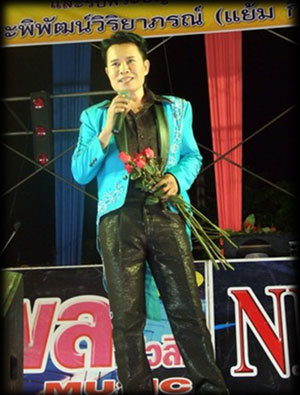
Monsit at Wat Rai Khing, he entered many contests before finding success-he was considered not attractive enough before being signed by Sure Audio in the 90’s. He sang with Fon, Amporn and others in the Cha Cha Cha group. His lilting melodic voice made him a big hit with numbers such as Gluwar. Not as popular as he once was maybe but still well worth a listen and a good concert performer who has a great sense of humour on stage, something the ladies are not very good at, with the exception of Appaporn and Janet keaw.
Echachi and Sunaree
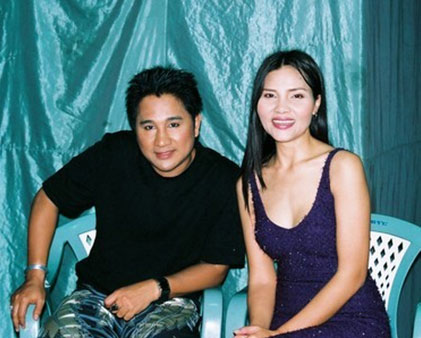
Echachi shivachi and Sunaree Rachasima at a Wat concert in Sukhumvit 101 on Christmas day 2003. He is a great performer and can sing many styles of Thai music, not just southern where he comes from. Thailand should be enormously proud
of these two great entertainers
Sunaree has the most beautiful voice in any form of Thai music, she is on another plane to everyone else and her forte is the ballad. As well as luktung she has also recorded lukrung. I tend to think she is taken for granted by Thais who sometimes forget
what a rare talent this woman possesses. Came to Min Buri when she was about 14 to work in the garment industry only to return home soon after. Later she returned again and heard a radio ad for a singing contest which of course she won. She writes
in her book about her sad personal life having married a man only to find out later he already had a wife who was pregnant at the same time as her. Sunaree has to be the most spellbinding singer and I cannot recommend her work
highly enough, to see her perform is a really thrilling experience. One of her greatest songs is Garaap Thaw Yaa Moo, not many other singers will try to sing this one, even in competitions.
Fon Tanasunthorn
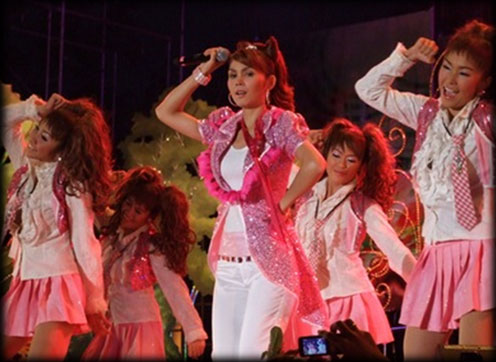
Fon at an AIS concert. Made a huge impact with her first three albums with Sure Audio in the early 2000’s Has been a little bit inconsistent since, here she sings Aye Jang , really bubble gum luktung if there was such a thing. Her best songs are
still Jai Orn and Ab Rak Khow. Recently appeared with Ying Yong, Pimpa Ponsri and Janet keaw in a morlam lakorn on channel 3 which has been very popular. Has recorded some great songs with Monsit, as well the female response to his Gluwar number.
As luktung singers are judged not just by their ability but on their character and rapport with the fans, I’m afraid she gets marked down for that. What you see is not quite what you get with khun Fon, great singer though.
Got
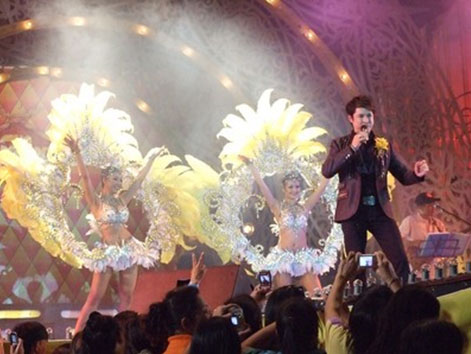
Got is such a talent and puts on such a great show he puts a lot of younger stars in the shade. Fantastic entertainment helped by the fact he only uses his own dancers who literally light up the stage. Once upon a time I believe he sang in Pattaya for
next to nothing which led to a less than great career in String music. Then Grammy persuaded him to try luktung and with the help of their very talented writers became a huge success in the 1990’s. Songs such as Taung Me Suk Wan and Jai
Sah Ra Parb are firm competition favourites and really beautiful songs. Has a bit of an offhand attitude with fans, but then he is half American! This guy is a true luktung star and his covers of Surapon’s songs are particularly worth hearing
as old luktung recording standards in Thailand did not always result in a very listenable sound to modern ears.
Tai Orathai
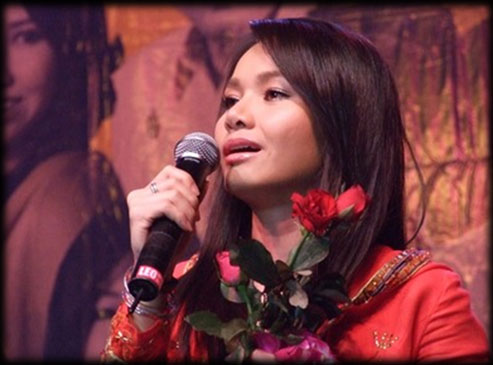
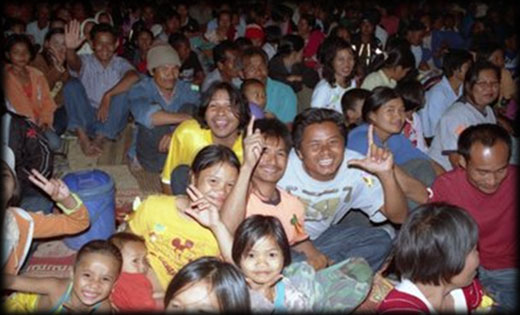
Concert crowds are friendlier than some would have you think
With the raising toll taken on album sales by the pirates I am pretty sure quite a number of singers actually make more from performing live or TV. To hire a top concert troupe might set you back as much as 200.000- 400.000 baht which sounds a lot but
that probably involves 100-150 people, singers, dancers, comics the band and assorted support staff. I asked a Major company several years ago what the rates were for their singers, then it was around 100.000 singing to a backing tape-no band
or dancers. However a new but very successful singer reported in 2008 in the Bangkok post she was earning just 100.000 baht a month from concerts. Some companies have dismissed a singer for arranging concerts ‘on the side’ so I imagine
the singers split is not that good. Some long time very famous faces seem to be above all this and act independently even though signed to a label.
People often ask how they can find when concerts are on. While there are a few websites listing them including those of recording companies they often seem to be out of date and I know many concerts are never listed. If you call the companies
the response can be from the very efficient to the absolutely clueless. It’s best to keep an eye out for boards advertising concerts put along the roads and also vans tour the area on the day with loudspeakers and posters. Radio FM95 and
88.5 also advertise upcoming events. There are certain places in Bangkok where there will be regular concerts, Sukhumvit 71 and 103 are two long time spots
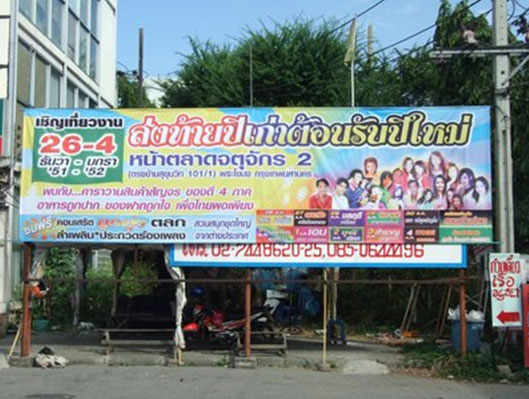
Sign for a concert on Sukhumvit road, Pumpuang’s younger sisiter was among those appearing
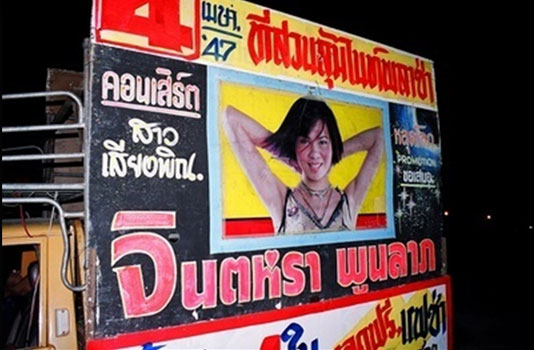
Vans often tour the district advertising on the day of a concert, this one was for Jintara in Bangkok.
Dancers and Costumes
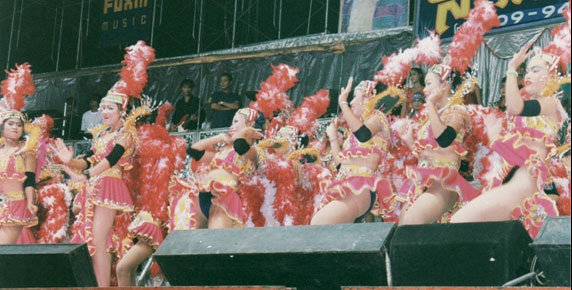
A concert is not complete without the dancers, male and female. Numbers vary from between 4 and 20 plus backing one singer at a time but a typical number is 7 or 9. The large touring troupes might have over 100 altogether. They range from the comically
inept, looking at each other for clues as what the next move is, to the highly professional. Costumes can be anything including fairies, monkeys, or traditional classical Thai or regional dress. More often it is feathers and sequins. Up to 15-20
changes of costume during a concert is not unusual. Unlike what you might have seen in other places of entertainment these girls actually dance!
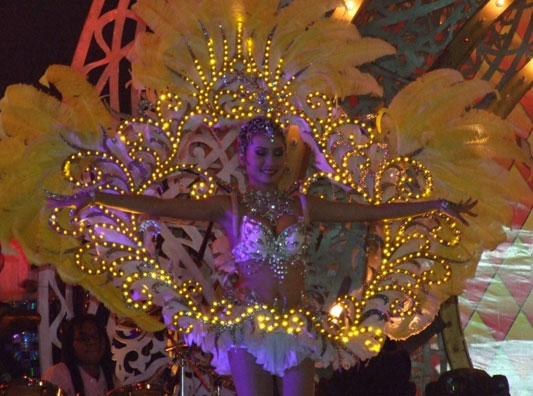
Let’s hope these are energy saving bulbs-one of Got’s dancers lighting up the stage
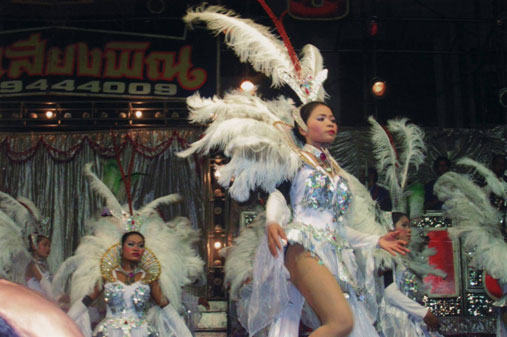
Feathers, sequins and tinsel, the dancers are anything but down to earth, even if the songs are.
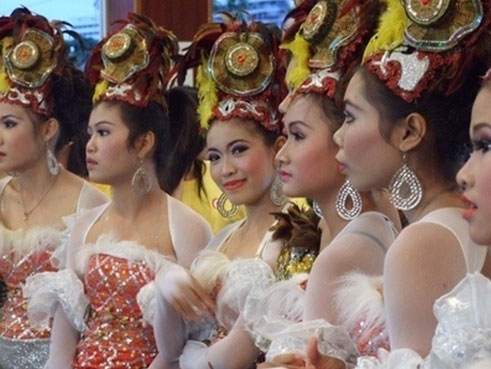
These girls were in a competition, many Schools and Universities have luktung troupes as dancers or with bands and singers, some of the talent is very impressive!
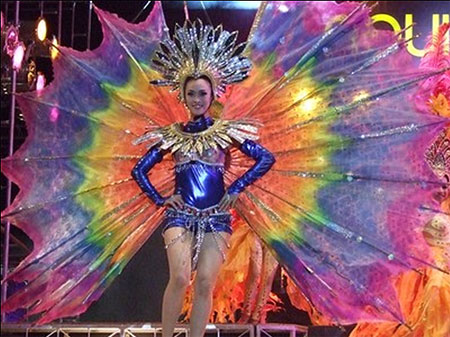
A dancer with M-150 tour, probably one of the best troupes of dancers around, great costumes.
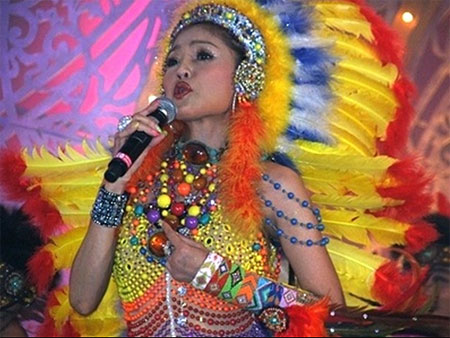
Dao Mayuree dressed as a fantasy Indian for no particular reason other than it looks eye catching.
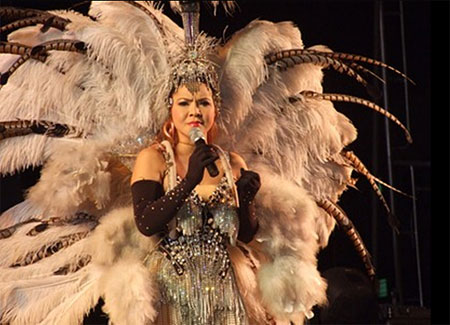
Singer Appaporn uses extravagant costume as a part of her act, looks like someone ruffled her feathers – aromseeya!
Some publications:
Siriporn Ampaipong autobiog -Parinya Chewit ISBN: 974-9442-0-4
Beats of the Heart Pantheon books ISBN: 0-394-74258-3
Sunaree Rachesima autobiog-Metro Publishing ISBN: 978-974-06-8792-4
Luktung by Jenpop Jobkrabunwan published by TK Park ISBN: 978-974-8218-83-0
Added to this there was a biog for Jintara published in 1992 but it has no ISBN number, FM 95 also published year books for several years from about 1999. There was a magazine called luktung Inter but I have not seen it around for a long time. There are several scholarly works with titles like Authenticity and modernity of luktung in a post rural… you can imagine what they are like, mostly written for PHDs etc. The University of Texas has some sort of Asian Music publications section which I think can be purchased online.
That’s it then. I could have written a lot more but hey it’s concert season! I know it’s not everyone’s cup of tea, but it is an important part of daily Thai life for many people. This is my Thailand and this is why I kept
going back there. I will be the first to admit that Thais are very bad at doing a lot of things including TV, customer service, and even being able to lay pavements half decently. However, when it comes to luktung and especially putting on a great
show they are world class and Thai luktung is a fabulous part of Thai culture.
I would just like to thank my beautiful Thai wife for putting up with my being stuck in front of the laptop for hours, and for helping with translating the some of the song titles and names and also reading me all of the Sunaree and Siriporn books.
I am always interested to hear about singers and sources of old records, tapes, books, CDs and autographs.
Stickman's thoughts:
Absolutely tremendous! It is clear to see a huge amount of work went into this!



